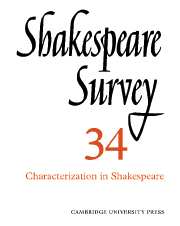Book contents
- Frontmatter
- Shakespeare’s Open Secret
- The Emergence of Character Criticism, 1774–1800
- Society and the Individual in Shakespeare’s Conception of Character
- Realistic Convention and Conventional Realism in Shakespeare
- On Expectation and Surprise: Shakespeare’s Construction of Character
- Shakespeare and the Ventriloquists
- The Rhetoric of Character Construction: Othello
- Characterizing Coriolanus
- The Ironic Reading of The Rape of Lucrece and the Problem of External Evidence
- The Unity of Romeo and Juliet
- No Abuse: The Prince and Falstaff in the Tavern Scenes of Henry IV
- Twelfth Night: The Experience of the Audience
- Plays and Playing in Twelfth Night
- Sceptical Visions: Shakespeare’s Tragedies and Jonson’s Comedies
- Shakespeare in Performance, 1980
- The Year's Contributions to Shakespearian Study 1 Critical Studies
- 2 Shakespeare’s Life, Times and Stage
- 3 Textual Studies
- Index
- Plate Section
No Abuse: The Prince and Falstaff in the Tavern Scenes of Henry IV
Published online by Cambridge University Press: 28 March 2007
- Frontmatter
- Shakespeare’s Open Secret
- The Emergence of Character Criticism, 1774–1800
- Society and the Individual in Shakespeare’s Conception of Character
- Realistic Convention and Conventional Realism in Shakespeare
- On Expectation and Surprise: Shakespeare’s Construction of Character
- Shakespeare and the Ventriloquists
- The Rhetoric of Character Construction: Othello
- Characterizing Coriolanus
- The Ironic Reading of The Rape of Lucrece and the Problem of External Evidence
- The Unity of Romeo and Juliet
- No Abuse: The Prince and Falstaff in the Tavern Scenes of Henry IV
- Twelfth Night: The Experience of the Audience
- Plays and Playing in Twelfth Night
- Sceptical Visions: Shakespeare’s Tragedies and Jonson’s Comedies
- Shakespeare in Performance, 1980
- The Year's Contributions to Shakespearian Study 1 Critical Studies
- 2 Shakespeare’s Life, Times and Stage
- 3 Textual Studies
- Index
- Plate Section
Summary
Bradley’s disquiet at the new King’s rejection of Falstaff at the end of 2 Henry IV continues to be suggestive because it raises so vividly questions about dramatic presentation and construction. Bradley is constantly bringing us up against the problem of how personal relations in the plays are constituted: How do the Prince and Falstaff communicate? How do we understand their relationship? Does the Prince have any affection for Falstaff? How would such affection be displayed? And alongside these are questions of structure: How is the conclusion prepared for? Which movements in the play culminate in this cruel confrontation? One way of approaching these problems is by looking at those of Bradley’s remarks which draw attention to the structure of the plays by suggesting that Shakespeare might have written them differently.
Bradley considers two ways in which Shakespeare might have tried to improve the plays. First, he might have strengthened sympathy for the Prince, or at least have provided him with some protection against charges of coldness and cruelty. This would not have been too difficult because it is obvious where Hal went wrong: 'He ought in honour long ago to have given Sir John to understand that they must say good-bye on the day of his accession' (p. 254).
- Type
- Chapter
- Information
- Shakespeare Survey , pp. 105 - 110Publisher: Cambridge University PressPrint publication year: 1982

